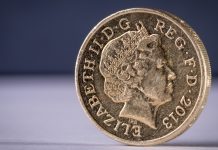The pound pushed back over US$1.2500 after Federal Reserve Chairman Jerome Powell as good as confirmed an interest rate cut in the US later this month. The pound US dollar exchange rate jumped 0.3% snapping a four-day losing streak. The pound was advancing further versus the dollar in early trade on Thursday.
| What do these figures mean? |
|---|
| When measuring the value of a pair of currencies, one set equals 1 unit and the other shows the current equivalent. As the market moves, the amount will vary from minute to minute.For example, it could be written:1 GBP = 1.28934 USDHere, £1 is equivalent to approximately $1.29. This specifically measures the pound’s worth against the dollar. If the US dollar amount increases in this pairing, it’s positive for the pound. Or, if you were looking at it the other way around:1 USD = 0.77786 GBPIn this example, $1 is equivalent to approximately £0.78. This measures the US dollar’s worth versus the British pound. If the sterling number gets larger, it’s good news for the dollar. |
The pound was upbeat prior to Jerome Powell’s comments owing to a better than forecast UK GDP reading. The UK economy grew at 0.3% in May from the month prior, up from a -0.4% contraction in April. Strong UK car production helped the UK economy stage a rebound. Manufacturing production also experienced a sharp upturn of 1.4% in May, up from a contraction of -4.2% in April. The dominant UK service sector, which accounts for around 80% of economic activity in the UK remained stubbornly stagnant.
Investors cheered the data as it means that the UK economy is likely to have avoided a contraction in the second quarter of the year. Thanks to better than forecast economic growth in May, analysts are now predicting that the UK economy stagnated with 0% growth in Q2, an improvement on the -0.1% contraction forecast for the three months April – June. The better than forecast data boosted the pound.
| How does strong jobs data boost the currency? |
|---|
| It works like this, when there is low unemployment and high job creation, the demand for workers increases. As demand for workers goes up, wages for those workers also go up. Which means the workers are now taking home more money to spend on cars, houses or in the shops. As a result, demand for goods and services also increase, pushing the prices of the goods and services higher. That’s also known as inflation. When inflation moves higher, central banks are more likely to raise interest rates, which then pushes the worth of the currency higher. |
Today investors will look towards the Bank of England’s (BoE) financial stability report for further clues as to whether the BoE will join other central banks across the globe by adopting a more dovish monetary policy.
Dollar Dives On Dovish Powell
The dollar dumped on Wednesday after Federal Reserve Chairman gave an undoubtedly dovish testimony to Congress in his semi-annual appearance. Jerome Powell as good as confirmed a rate cut in July, despite the strong US jobs report last Friday. He cited increased risk from uncertainties stemming from weakening foreign economies, trade tensions and Brexit as causes for concern. As a result, investors have cemented their expectation of a rate cut later this month and are focusing on the probability of another cut before the end of the year.
| Why do interest rate cuts drag on a currency’s value? |
|---|
| Interest rates are key to understanding exchange rate movements. Those who have large sums of money to invest want the highest return on their investments. Lower interest rate environments tend to offer lower yields. So, if the interest rate or at least the interest rate expectation of a country is relatively lower compared to another, then foreign investors look to pull their capital out and invest elsewhere. Large corporations and investors sell out of local currency to invest elsewhere. More local currency is available as the demand of that currency declines, dragging the value lower. |
The dollar will remain very much in focus again today as investors digest a second appearance by Jerome Powell on Capitol Hill and a slew of high impacting data. US inflation could drag the dollar lower. Analysts forecast that inflation will drop to 1.6%, down from 1.8% as it moves further from the Fed’s 2% target.
This publication is provided for general information purposes only and is not intended to cover every aspect of the topics with which it deals. It is not intended to amount to advice on which you should rely. You must obtain professional or specialist advice before taking, or refraining from, any action on the basis of the content in this publication. The information in this publication does not constitute legal, tax or other professional advice from TransferWise Inc., Currency Live or its affiliates. Prior results do not guarantee a similar outcome. We make no representations, warranties or guarantees, whether express or implied, that the content in the publication is accurate, complete or up to date. Consult our risk warning page for more details.
This article was initially published on TransferWise.com from the same author. The content at Currency Live is the sole opinion of the authors and in no way reflects the views of TransferWise Inc.





